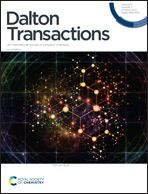Effect of cysteine thiols on the catalytic and anticancer activity of Ru(ii) sulfonyl-ethylenediamine complexes†
Abstract
We have synthesized a series of novel substituted sulfonyl ethylenediamine (en) RuII arene complexes 1–8 of [(η6-arene)Ru(R1-SO2-EnBz)X], where the arene is benzene, HO(CH2)2O-phenyl or biphenyl (biph), X = Cl or I, and R1 is phenyl, 4-Me-phenyl, 4-NO2-phenyl or dansyl. The ‘piano-stool’ structure of complex 3, [(η6-biph)Ru(4-Me-phenyl-SO2-EnBz)I], was confirmed by X-ray crystallography. The  values of their aqua adducts were determined to be high (9.1 to 9.7). Complexes 1–8 have antiproliferative activity against human A2780 ovarian, and A549 lung cancer cells with IC50 values ranging from 4.1 to >50 μM, although, remarkably, complex 7 [(η6-biph)Ru(phenyl-SO2-EnBz)Cl] was inactive towards A2780 cells, but as potent as the clinical drug cisplatin towards A549 cells. All these complexes also showed catalytic activity in transfer hydrogenation (TH) of NAD+ to NADH with sodium formate as hydride donor, with TOFs in the range of 2.5–9.7 h−1. The complexes reacted rapidly with the thiols glutathione (GSH) and N-acetyl-L-cysteine (NAC), forming dinuclear bridged complexes [(η6-biph)2Ru2(GS)3]2− or [(η6-biph)2Ru2(NAC-H)3]2−, with the liberation of the diamine ligand which was detected by LC-MS. In addition, the switching on of fluorescence for complex 8 in aqueous solution confirmed release of the chelated DsEnBz ligand in reactions with these thiols. Reactions with GSH hampered the catalytic TH of NAD+ to NADH due to the decomposition of the complexes. Co-administration to cells of complex 2 [(η6-biph)Ru(4-Me-phenyl-SO2-EnBz)Cl] with L-buthionine sulfoximine (L-BSO), an inhibitor of GSH synthesis, partially restored the anticancer activity towards A2780 ovarian cancer cells. Complex 2 caused a concentration-dependent G1 phase cell cycle arrest, and induced a significant level of reactive oxygen species (ROS) in A2780 human ovarian cancer cells. The amount of induced ROS decreased with increase in GSH concentration, perhaps due to the formation of the dinuclear Ru-SG complex.
values of their aqua adducts were determined to be high (9.1 to 9.7). Complexes 1–8 have antiproliferative activity against human A2780 ovarian, and A549 lung cancer cells with IC50 values ranging from 4.1 to >50 μM, although, remarkably, complex 7 [(η6-biph)Ru(phenyl-SO2-EnBz)Cl] was inactive towards A2780 cells, but as potent as the clinical drug cisplatin towards A549 cells. All these complexes also showed catalytic activity in transfer hydrogenation (TH) of NAD+ to NADH with sodium formate as hydride donor, with TOFs in the range of 2.5–9.7 h−1. The complexes reacted rapidly with the thiols glutathione (GSH) and N-acetyl-L-cysteine (NAC), forming dinuclear bridged complexes [(η6-biph)2Ru2(GS)3]2− or [(η6-biph)2Ru2(NAC-H)3]2−, with the liberation of the diamine ligand which was detected by LC-MS. In addition, the switching on of fluorescence for complex 8 in aqueous solution confirmed release of the chelated DsEnBz ligand in reactions with these thiols. Reactions with GSH hampered the catalytic TH of NAD+ to NADH due to the decomposition of the complexes. Co-administration to cells of complex 2 [(η6-biph)Ru(4-Me-phenyl-SO2-EnBz)Cl] with L-buthionine sulfoximine (L-BSO), an inhibitor of GSH synthesis, partially restored the anticancer activity towards A2780 ovarian cancer cells. Complex 2 caused a concentration-dependent G1 phase cell cycle arrest, and induced a significant level of reactive oxygen species (ROS) in A2780 human ovarian cancer cells. The amount of induced ROS decreased with increase in GSH concentration, perhaps due to the formation of the dinuclear Ru-SG complex.



 Please wait while we load your content...
Please wait while we load your content...